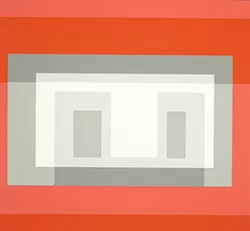
The University of Arizona Museum of Art this Saturday, Aug. 31, opens a major show on the Bauhaus, the legendary German art school that championed a utopian vision of art. Created by architect Walter Gropius in 1919, after the brutal devastation of World War I, the school's influential architects, craft artists, designers and visual artists aimed to unite all the art forms, and to merge fine art with industry. The influential school was forced by the Nazis to close in 1933, but its sleek aesthetics—favoring abstraction over figuration, simplicity over ornamentation—had an incalculable impact on modern art and architecture.

Organized by curatorial intern Morah Riedl, whose thesis on the Bauhaus earned her an MA in art history at the UA, the show, A New Unity: The Life and Afterlife of Bauhaus, is divided into two parts. One gallery will house works by Bauhaus artists, including woodcuts by Josef Albers, and Lyonel Feininger, and no fewer than five weavings by Anni Albers.
The other will showcase later artists influenced by the Bauhaus, including Bridget Riley, known for her bold black-and-white "movement in squares," the hard-edged colorist Ellsworth Kelly and minimalist Donald Judd. Current UA art students contributed a nine-panel print that gives the Bauhaus a desert twist, and the Center for Creative Photography has lent photographs.
The exhibition opens Saturday, Aug. 31, and continues through Dec. 1. Among the accompanying events, German and gender studies prof Barbara Kosta speaks at 4 p.m., Thursday, Oct. 17, on the "modern woman" in 1920s Berlin. Art history prof Paul Ivey gives a talk at 4 p.m., Thursday, Nov. 14, on the little-discussed religious dimensions of the Bauhaus. artmuseum.arizona.edu.
The Center for Creative Photography, across the way from UAMA, will host a Bauhaus afternoon on Sunday, Oct. 6. A movie, Bauhaus: The Face of the 20th Century, will be screened at 2 p.m. From 3 to 4 p.m., visitors can view CCP's collection of Bauhaus-related photos, and from 3 to 5 p.m. they can visit the UAMA exhibition for free. Esther Steinberg, M.D., a prof in the College of Medicine and research director of the Arizona Center for Integrative Medicine, gives opening remarks at 1 p.m. From 3 to 4 p.m., she will sign copies of her book Healing Spaces: The Science of Place and Well-Being.
Film Fest Tucson will show the movie Bauhaus Spirit:100 Years of Bauhaus. The annual downtown film festival, now in its fourth year, will run the movie at 8:30 p.m., Friday, Oct. 11, at the AC Hotel. Tickets for this film and others in the fest are available in early September at filmfesttucson.org. For a sneak peak, check out the trailer on YouTube.
And of course, Tucson Modernism Week 2019, running Oct. 5 to 13, will give tour, lectures and other events related to Tucson's collection of mid-century modern architecture, much of it inspired by Bauhaus principles. preservetucson.org.
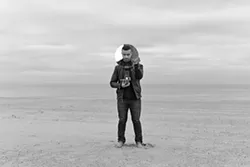
The Bauhaus anniversary is not the only milestone animating art exhibitions this season. Walt Whitman's 200th birthday fell on May 31 this year, and the Center for Creative Photography, opened its months-long show A Portrait of Poetry that very day. Portrait honors the great poet by bringing attention to his literary descendants. Some 80 startling portraits of contemporary poets, both famous and not, were shot in the last few years by by photog B.A. Van Sise. Each of the elaborate images, of poets in dark forests, city streets and sex theaters, hang on the gallery walls next to the poem that inspired them. The exhibition continues through Nov. 23. A companion show, Edward Weston's Leaves of Grass, features 1940s images of America that Weston made for a luxe edition of Whitman's poetic masterpiece. Through Nov. 30. ccp.arizona.edu.
A collaboration with the UA Poetry Center, the show also features four free poetry readings, in two locations, by a select few of the exhibition poets.
UA Poetry Center readings: Erika Sánchez and Sam Sax read from their work at 7 p.m., Thursday, Sept. 5. Arthur Sze reads at 7 p.m., Thursday, Nov. 14. poetry.arizona.edu.
Center for Creative Photography readings: Kim Addonizio, Javier Zamora and Joseph Legaspi will read at 6 p.m., Thursday, Sept. 12. Matthew Zapruder gives both a lecture and a poetry reading at 6 p.m., Thursday, Nov. 7.
In further photography doings, the CCP is organizing a show of work by Pulitzer Prize-winning photographer David Hume Kennerly, who's been designated a Presidential Scholar at the UA. Kennerly won his Pulitzer at age 25, for photos of the Vietnam War, the 1971 Joe Frazier/Muhammad Ali boxing "match of the century" and more. His famous photos will hang at Old Main, the campus's oldest building, starting on Oct. 11 and continuing indefinitely. During Parents' Weekend, Oct. 11-13, large-scale copies of Kennerly's works will be hung outside on the UA Mall.
Still active at 72 (he recently covered the Robert Mueller hearing), Kennerly will speak at a free event at Centennial Hall at 7 p.m. Friday, Oct. 11, participating in conversation with another Pulitzer winner, Jon Meacham, an author and former Newsweek editor-in-chief. Free, but the required tickets will likely go fast. Get them on the UA Presents web site in September.
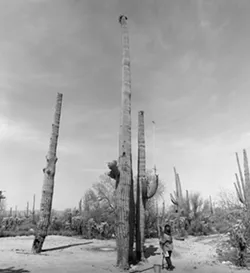
On Oct. 26, a mask exhibition, Pahko’ora/Pahko’ola: Mayo and Yaqui Masks from the James S. Griffith Collection, will open at the museum. The show examines the ritual importance of the wooden Pascola dancer masks used by Mayo and Yaqui people of Northern Mexico and Southern Arizona. Mayo member Santiago Benton and Yaqui Pascola elders curated the exhibition in collaboration with ASM and Griffith. Donated to the museum by folklorist Griffith, better known at Big Jim, the masks will be on view through December 2020.
Sorting Race, a provocative exhibition about racially charged thrift store donations, opens Sept. 2. The traveling show looks at children’s books, playing cards and other goods emblazoned with racialized imagery from another era. It raises the question: should these objects be sold to customers—or permanently pulled out of the inventory? Closes Feb. 29. Statemuseum.arizona.edu.
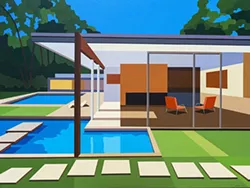

The excellent Bernal Gallery at Pima Community College West Campus also exhibits both paintings and photographs this fall. The Fortoul brothers, Gabriel and Isaac, open the season Sept. 3 with Altruistic Benevolence, a wild painting show of bold colors and imagery. Well known in Phoenix for their public murals, the New Jersey natives—children of immigrants from Colombia—will speak at 6 p.m. Thursday, Sept. 12, during a reception from 5 to 7 p.m.
Take Nothing for Granted, running Oct. 26 to Dec. 6, features 12 artists familiar to Tucson art lovers, including painters Jenny Day and Lawrence Gipe, and photographers Kate Breakey and the renowned Danny Lyon, who exhibits frequently at Etherton. Guest artist Paula Crawford, a prof at George Mason U, tackles the wrenching issue of refugee migration. Giving Tucsonans a look at migration elsewhere, two of her large paintings take us to the Mediterranean. In one, human beings fight for their lives as they cling to flimsy rafts at sea. Reception and artist talk 5 to 7 p.m., Thursday, Nov. 7. pima.edu/cfa
Back here in the Sonoran Desert, in one of the hottest, driest summers in memory, the migrant death toll has risen. Fittingly, the tragedy of migrant deaths is the subject of the Tucson Desert Art Museum’s major fall exhibition.
Delilah Montoya, a photographic printmaker born in Texas and now living in New Mexico, has given her show the poignant title Sed, The Trail of Thirst. (Sed is the Spanish word for “thirst.”) In her images, Montoya documents the travails of desperate migrants crossing the Southwest border in search of a better life and honors the courageous souls who die trying. One richly colored image shows a storm blowing in from the mountains; on the desert floor three Humane Borders water barrels await the next thirsty migrants. Above, a blue flag, whipping in the wind, signals that lifegiving water is here. Sept. 18 to Feb. 28.
A second show, SNAP! Snapshots of History Through Vintage Advertising, interrogates old-time ads replete with racial and gender stereotype. Like Sorting Race at the Arizona State Museum, it challenges visitors to look at the vintage materials as windows into the past. Sept. 18 to Nov. 30. tucsondart.org.
A project that memorializes a shipwreck heads a trio of fall exhibitions at MOCA-Tucson. The wreck occurred in 1948, when a British fishing trawler went down off the coast of Iceland; 70 years later, its scattered remains still lie on a remote beach. Artist Al Silverstein has been documenting the loss with photographs, a video and rubbings of the ship fragments, a process that he says is both ritual and remembrance. The exhibition, Chapter 1: The Fragments, is only the first part of his project; he ultimately aims to make a “fantastical reconstruction” of the ship.
In Close Encounters, Caroline Wells Chandler, a multimedia artist, shows his queer crocheted pieces. Inspired by American folk art, psychedelia and 1970s feminist crafts, the works explore gender and the art canon. In the video Thresholds, Rachel Franks focuses on wildlife passages in southern Arizona, and ponders borderlands fragmentation by borders, climate change and drought. All three MOCA shows begin Oct. 5 and end Dec. 29.
Three summer shows continue at MOCA until Sept. 27. Groping in the Dark features installations and videos by 10 artists about the way humans treat the land. From Here to Eternity introduces the work of 12 new MFA grads of the UA, and seven new BFA grads. New Histories showcases pieces by artists who are even younger—school kids from kindergarten to 12th grade.
The Tucson Museum of Art’s big fall show takes on a big subject: America’s purple mountain majesties. Through paintings, drawings, photography, prints, textiles, and basketry, The Western Sublime: Majestic Landscapes the American West investigates the “sublime”—the awe that early artists felt when they first saw the towering peaks and infinite vistas of the West. The show also introduces contemporary works that take on those overpowering landscapes. Peter Allen Nisbet’s lovely 2012 oil “Sovereign Sky” is a classic three-part western view: a big sky above glowing yellow and blue, and below, a long, low stretch of mountains and the softly rolling range. Oct. 19 to Feb. 9.
Harry Brorby: The strength of a cold line recaps the long career of a Chicago-born artist (1927-2012) who moved back and forth from figurative expressionism to spare abstraction. Over four decades, Brorby experimented with painting, printmaking and sculpture; his works are in a host of museums, from MoMA in New York to the Art Institute of Chicago. Midwesterner Brorby spent the last years of his life in Tucson. Oct. 19 to Feb. 9.
Three shows are drawn from the museum’s permanent collections. I’m Every Woman: Representations of Women on Paper takes a look at TMA’s holdings of images of women. These drawings and prints range across time and cultures, picturing women as mothers or daughters, as lovers and as heroes. Paul C. Valadez’s “Abuela” is a bright screenprint portrait of a cheery, youthful grandma. But the works’ points of view vary dramatically, with women “idolized or criticized, respected or ridiculed.” Sept. 5 to Sept. 6, 2020.
Ralph Gibson: Photographs lionizes the celebrated American photographer who has made his elegant black-and-whites for 50 years. Born into Hollywood royalty, he learned photography during a stint with the U.S. Navy. A typical piece, “Striped Shirt Pen,” gives exactly what the title promises: a man’s hand holding a pen and a wonderfully striped black-and-white shirt cuff. Sept. 5 to Sept. 6, 2020.
Oaxacan Folk Art from the Shepard Barbash and Vicki Ragan Collection is a sumptuous homage to the innovative indigenous artisans in one of Mexico’s poorest states. Ragan and Barbash, a married couple, recently donated a treasure trove of Oaxacan wood carvings and ceramics to the museum, considerably plumping up its Latin art holdings. Among many delights is “Red and White Striped Cat,” a painted wood figure by Margarito Melcho and Maria Teresa Santiago, a coiled feline as flexible as any yogi. October 3 to August 9, 2020.
The summer show at Joseph Gross Gallery, the cutting-edge arts space at the UA, continues through Sept. 9. Transiting 2, is about “time, travel and dislocation.” The 15 artists include Lawrence Gipe, who is also showing at Bernal Gallery at Pima this fall. Reception 5 to 6:30 p.m. Thursday, Aug. 29. Next up is a show of selected works from Birds of Paradise by Sara Golish, Sept. 12 to Nov. 14, followed by the intriguingly titled The Snake Eats Its Tail, Nov. 21 to Jan. 23. art.arizona.edu.
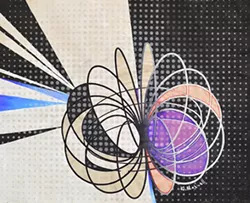
Arizona Print Invitational, the gallery’s first show of the season, runs Sept. 20 to Nov. 19. Fifteen Arizona printmakers will display works in a multitude of printmaking techniques from traditional to contemporary. Some of the innovations have prints sprouting into 3-D or turning into a book. A reception will take place 6 to 8 p.m., Saturday, Oct. 5, during the Big Picture season opener for the Central Tucson Gallery Association, when many galleries open their doors the same night.
Next, 4 Women Artists puts the spotlight on paintings by Debra Salopek, a marvelous landscape painter, and Susan Conaway, who paints somber still lifes; painted photogravures by Patricia Carr Morgan, whose Artic images wowed at the TMA last spring; and sculpture by Tucson’s prolific Barbara Jo. Nov. 15 to Jan. 4. Davisdominguez.com
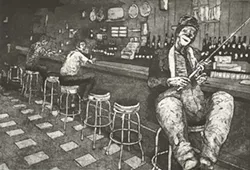
Closing party Oct. 19. At a fall fundraiser in the gallery from 6 to 8 p.m., Sept. 28, “Tucson Troubadour” Ted Ramirez plays acoustic music with Ismael Barajas on Spanish classical guitar. $10 gets you in and gives you a dinner.
Raices’s annual Día de los Muertos show, featuring homemade altars and ofrendas, opens on the big day itself, Nov. 2, with a grand party from 6 to 9 p.m. Mariachi musicians will play live; guests should bring food for a potluck. Closes Nov. 16. The annual small works holiday show, Nov. 23 to Jan. 4, will display an array array of art on sale for less than $200 apiece. Raicestaller222.com.
Contreras Gallery, next door to Davis Dominguez, offers up a political show Sept. 7 to 28. Just the FACs Ma’am rounds up three satirists: David “Fitz” Fitzsimmons, cartoonist for the Arizona Daily Star; painter Gary Aagaard; and Rand Carlson, a painter and tin artist and a Tucson Weekly cartoonist. These three scathing gents will stop at nothing to get a laugh—and to afflict the comfortable, as the old journalism saw goes. “Swamp Shell Game,” an Aagaard painting of President Trump and Mitch McConnell as a pair of carnally joined turtles, is one of the most horrifying things you’ll ever see. Opening reception 6 to 9 p.m., Sept. 7.
Eight shutterbugs fill the gallery in Photography: to wit, Leslie Anne Epperson, Stu Jenks, Keith Marroquin, Jeff Smith, David Andres, Mirle Friel, John Gilky and Peter Hogan. Opening reception 6 to 9 p.m., Oct. 5, for the Big Picture. Closes Oct. 26. Fantasy and Surrealism, another group show, opens with a reception 6 to 9 p.m., Nov. 2; closes Nov. 30. The popular Milagros show, featuring ex votos, retablos and other religious folk art, will be up for two months, opening with a reception 6 to 9 p.m., Dec. 7, closing Jan. 31. Contrerashousefineart.com
Gallery 2 Sun, just west of Contreras, has curated two abstract expressionist shows that readily mesh with Tucson Modernism Week. Pick up the Beat is the first Tucson exhibition for Howard Kline, a contemporary abstract expressionist painter who lives in the Old Pueblo. His work is paired with a Retrospective for the late Israel “Jack” Levitan. In the 1950s and ’60s, Levitan (1912-1982) was associated with the New York school of abstract expressionism, The gallery displays his sculptures, along with some sketches and paintings. Opening reception for Kline is on First Saturday, Sept. 7; for Levitan, the reception is on First Saturday, Oct 5. The dual shows both run Sept. 7 to Oct. 26. gallery2sun.com. Tucson Modernism Week runs Oct. 5-13.
Tom Philabaum has stepped away from glassblowing, and his old glory hole furnace is gone from the studio, but he’s still making glass art in other ways, including painting and layering panes of glass. Philabaum Glass Gallery re-opens for business Sept. 3 after a summer break. The gallery, at Five Points south of downtown, exhibits its founder’s works as well as glimmering glass of all kinds by some 45 artists from some 45 artists from all over the country. Philabaumglass.com.
Pigs will overrun Arte de la Vida this fall in midtown. Luckily these 40 porkers are on the small side, just 12 by 14 inches, they’re made of plaster and they will be intensively decorated by 40 artists. Still more pigs will be turned into artworks by a gaggle of schoolchildren. Among the grownup artists are Calie Kilpatrick, Emily Costello and Sherrie Posternak, who frequently shows at Raices Taller. The kids’ pigs will be auctioned off to raise money for Educational Enrichment Foundation (EEF), a nonprofit that provides shoes and other goods to needy students. Show runs October and November. Artedelavidatucson.com.
Tohono Chul Gallery, in a park on the northwest side, opens its season with its annual Día de los Muertos show. The early-bird celebration of the November holy day begins with an artist reception from 5:30 to 8 p.m., Friday, Aug. 30 -. The show’s works honoring death, the departed and the living come in all forms: paintings, photos, mixed media, prints, drawing. Stu Jenks, who also has work at Contreras in October, photographed a lush desert landscape in full color; at its center stands a tiny chair that evokes a lost loved one. James Burton also goes down into the desert to make his mournful piece. He memorializes the migrant dead in a black-and-white photo of a cross; planted among the prickly desert shrubs, it marks the remote spot where somebody’s mother, or brother, or child died. Through Nov. 6.
The Mini Time Machine Museum of Miniatures is keeping busy throughout the upcoming season with four exhibits, ranging from ghost towns to holiday lights. The Borrowed Time / Borrowed Books exhibit, running through Sept. 15, features six miniature libraries constructed of steel and filled with (what else?) memory. Mario Patino’s Ravished Landscapes and Rundown Interiors, running through Dec. 15, features a series of miniature, very much lived-in vignettes created by a lifelong Tucsonan. Jean Leroy’s Buzzard Creek Ghost Town, running through Nov. 3, is the quintessential Western town, but only husks remain where the cowboys once stood. Holidays Around the World and Through Time, running through Jan. 5, features holiday scenes from Germany, Denmark, WWII-era New York, Japan and more. theminitimemachine.org













